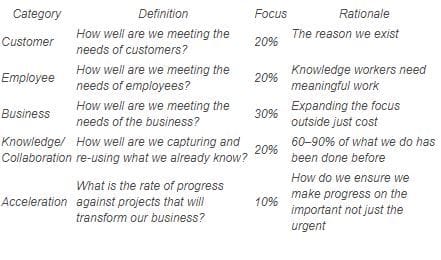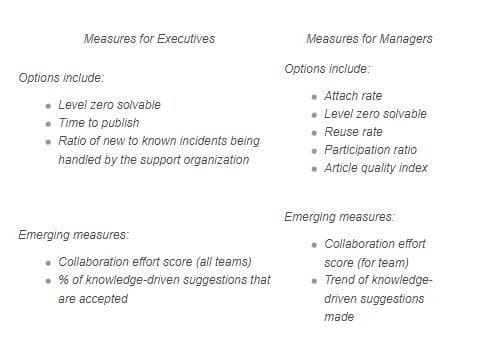Most leaders in support organization struggle with knowing what to measure and how to change the focus from tactical break fix measures to more strategic conversations. We measure too much, and much of what we measure isn’t actionable. So we end up putting goals on activities that are easy to measure and easy to manipulate.
An example? I’m glad you asked. One from the knowledge management world is “creating or updating two knowledge base articles a week.” Goals on measures like this drive all sorts of undesirable behavior.
Remember, the best run organizations have a strategy everyone understands with ways to connect behaviors to achieve that strategy. It’s far better to have a few balanced measures with the following characteristics:
- Simple enough to focus attention on a few key elements that are important
- Fair enough so that people at every level believe they can affect the measures
- Facilitates an environment of learning and dialoguenot of control and compliance
The good news is that there is a new, open, modern metrics standard, the Open Customer Metrics Framework (OCMF) for IT, customer support, and customer success.
The framework has five categories of measures, and within that, suggested measures for executives and suggested measures for managers. The idea is to make sure we have a balance between listening to our customers, employees, and the business and applying what we learn. There has to be a clear line of sight between the objectives of the organization and what each person can affect.
Important note: The focus percentage is not a weighting factor for measures. It is the suggestion for percentage of focus we expect an executive would spend on a category of measures. Your business may have a different percentage based on your business needs at a particular moment in time.
OCMF suggests that executives should spend about 20% of their time on knowledge management, the Knowledge/Collaboration category.
For those of you keeping score at the office, this is the same percentage focused on customers and employees. Yes, it is that important. Your employees know this.
Let’s walk through the intent behind the knowledge/collaboration measures for executives, shown in the table below compared to those for managers.
The first two measures for executives address getting most of the knowledge that your organization has into the hands of your customers as quickly as possible. The third looks at how much of your knowledge is reused. The fourth reveals how easy (or not) teams can collaborate with other groups. The fifth looks at how well you are harvesting actionable information from your knowledge articles.
- Level Zero Solvable. Take the actual words your customers use when they contact you via phone and use these as search terms on your website or online community to see what percentage of issues could have been solved by your customers if this information were available online. (Of course, if you can’t find it, neither can your customers. If it doesn’t exist, this becomes your first improvement to make.)
- Time to Publish. This is a measure of how fast it takes to go from known internally to available externally. (Think minutes, not weeks, and start whittling it down on the new content your team needs to create. Done is better than perfect.)
- Ratio of New vs. Known. Of the issues that come in, what percentage are solved using content you already have in your existing knowledge base?
The next two are emerging measures. We aren’t quite sure of the best way to measure them, but this should be directionally correct.
- Collaboration Effort Score. This measure will give you a sense of how easy or difficult it is for teams to interact across groups. This is an emerging measure that is best handled by a survey question. Something like “Department X makes it easy for me to collaborate with them.”
- Percent of knowledge-driven suggestions that are accepted. This measure closes the loop between actionable information from reviewing your knowledge article usage and reports and you doing something about it as an executive.
Aren’t these far more relevant to your leaders than detailed statistics about your knowledge management program? How do you get started? Just do it, before your employees and customers leave you to for an organization that listens to them and acts on what they learn better than you do.
If you still have questions, reach out to me or any of the people who helped with the standard, and we will be glad to walk you through this framework. We can also connect you with a growing number of innovative leaders making a difference in their organizations by moving to OCMF.


